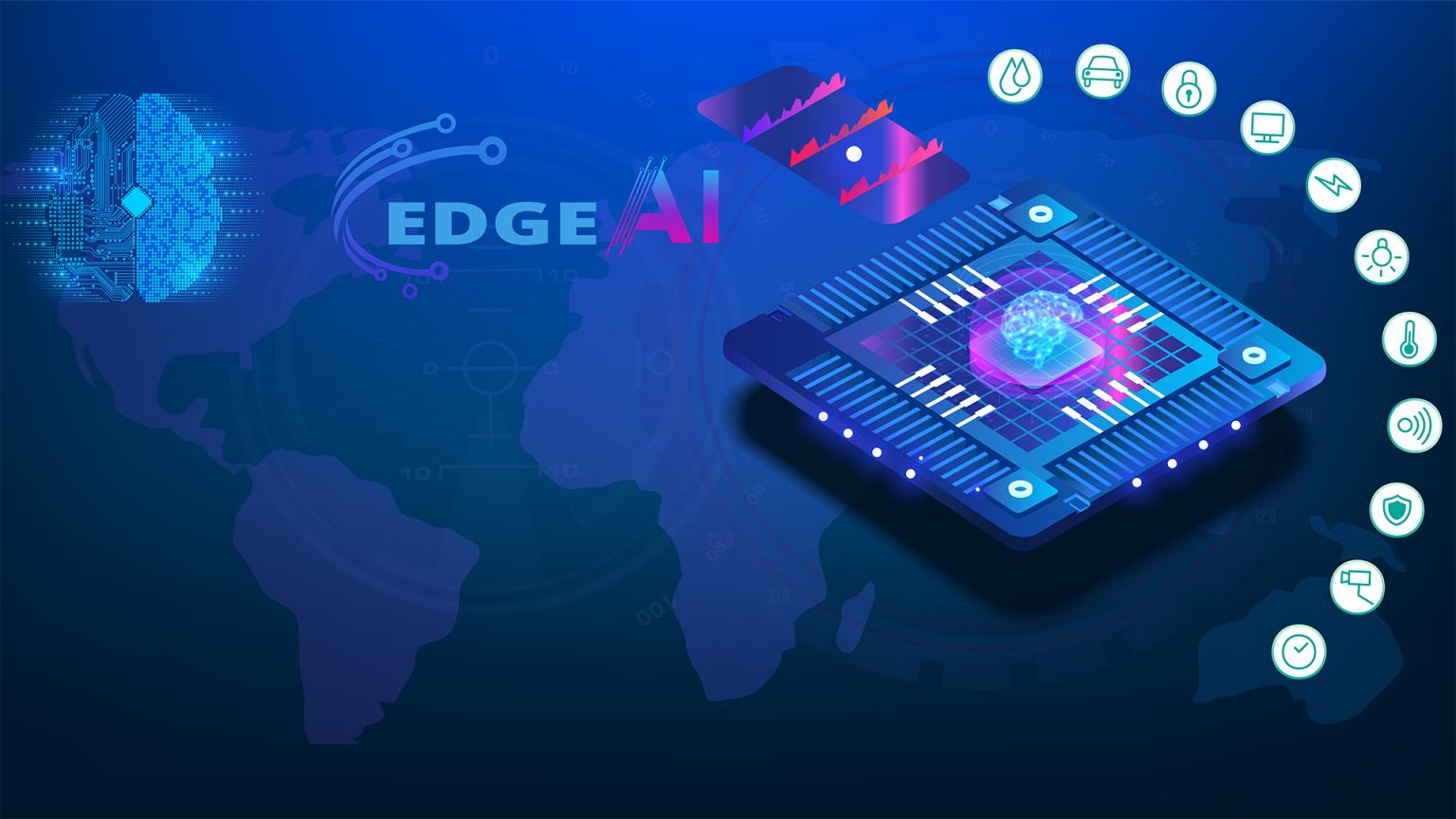We are living in a time when intelligence is no longer confined to human minds or distant supercomputers. Artificial intelligence (AI) has leapt from theory into daily life, powering everything from streaming recommendations to medical diagnoses. But a quiet revolution is now reshaping the way AI is deployed. Instead of sending every query to faraway data centers, intelligence is moving closer to us—into our phones, cars, appliances, cameras, and even wearable devices. This is Edge AI: a technological shift that places artificial intelligence directly on the devices we use every day.
Edge AI is more than a buzzword. It is the natural evolution of computing, driven by the need for speed, security, efficiency, and independence from the cloud. Imagine a smart speaker that responds instantly without sending your voice to a server, a car that makes split-second driving decisions without waiting for an internet signal, or a medical device that analyzes health data without ever leaving your wrist. These possibilities are not futuristic speculation—they are here now, reshaping industries and everyday experiences.
What Edge AI Really Means
At its heart, Edge AI refers to the deployment of artificial intelligence models on local devices—often called “the edge”—rather than relying solely on cloud-based systems. The edge includes smartphones, sensors, cameras, wearables, vehicles, drones, and countless other connected machines.
Traditionally, AI systems required massive amounts of computing power and storage, which meant data had to be sent to cloud servers for processing. This was acceptable for applications like search engines or photo backups, where response time wasn’t critical. But for tasks demanding instant reaction, such as autonomous driving, industrial automation, or augmented reality, cloud dependence introduced unacceptable delays.
By embedding intelligence directly at the edge, devices can analyze data where it is generated, make decisions in real time, and operate even when disconnected from the internet. Edge AI is not replacing the cloud; rather, it complements it, creating a distributed intelligence where some tasks are handled locally and others centrally, depending on the need.
Why Intelligence is Shifting to Devices
The migration of AI to the edge is not a coincidence—it is the result of converging technological, social, and economic forces. Several key drivers are accelerating this shift, each reflecting a pressing need in our hyperconnected world.
First, speed is paramount. Many applications cannot tolerate the latency of sending data back and forth to the cloud. In autonomous vehicles, a fraction of a second can mean the difference between safety and disaster. In healthcare, immediate insights from wearable sensors can detect anomalies before they become emergencies. Edge AI enables decisions to be made on the spot, in milliseconds, with no reliance on remote servers.
Second, privacy and security have become critical concerns. In an age of constant surveillance, people and organizations are rightly worried about where their data goes and who has access to it. Edge AI minimizes exposure by keeping sensitive information—like biometric data, audio recordings, or personal health metrics—on the device itself. This local processing reduces risks associated with data breaches, government surveillance, or misuse by corporations.
Third, efficiency matters. Constantly transmitting large amounts of raw data consumes bandwidth and energy. Consider the flood of video footage from security cameras or the sensor data from industrial machines. Sending all of it to the cloud is impractical and costly. With Edge AI, data can be filtered and analyzed locally, with only the most relevant insights sent to the cloud, dramatically cutting energy and network demands.
Fourth, resilience plays a role. Devices that rely on cloud servers are vulnerable to outages or poor connectivity. Edge AI systems can continue operating independently, ensuring continuity in critical scenarios. A drone mapping a disaster zone, for example, cannot afford to lose functionality because of weak internet coverage. Local intelligence ensures autonomy.
The Evolution of Hardware and Software
Edge AI has been made possible by remarkable advances in hardware and software. Not long ago, running sophisticated AI models required the computational muscle of powerful servers equipped with high-end graphics processing units (GPUs). But miniaturization, specialized chip design, and optimization techniques have changed the equation.
Modern smartphones now contain neural processing units (NPUs) that are tailored for machine learning tasks, enabling real-time language translation, face recognition, and image enhancement without external servers. Microcontrollers embedded in small devices have become powerful enough to run lightweight AI algorithms for tasks like predictive maintenance or voice activation.
At the same time, advances in software have produced efficient AI models designed for the edge. Techniques such as model pruning, quantization, and knowledge distillation reduce the size and complexity of neural networks without sacrificing performance. This allows devices with limited power and storage to handle tasks once reserved for data centers.
Open-source frameworks and toolkits, such as TensorFlow Lite, ONNX Runtime, and PyTorch Mobile, have accelerated the adoption of Edge AI, giving developers accessible tools to optimize and deploy models on edge devices. Together, these innovations have democratized intelligence, making it feasible to put AI into almost any connected object.
Everyday Examples of Edge AI
Many people encounter Edge AI without even realizing it. Smartphones are perhaps the most familiar showcase. Face unlocking, photo categorization, augmented reality filters, and predictive typing are all powered by models running directly on the device. The speed and responsiveness we take for granted are made possible by local processing.
Smart homes also benefit from Edge AI. Voice assistants are increasingly capable of handling commands without sending recordings to the cloud, improving privacy and reducing lag. Security systems with AI-powered cameras can distinguish between a stray cat and a potential intruder without streaming constant footage to external servers.
Wearables offer another compelling example. Fitness trackers and smartwatches monitor heart rates, sleep cycles, and oxygen levels in real time, providing immediate feedback. By processing data locally, they can alert wearers to irregularities without compromising privacy.
In transportation, autonomous vehicles represent the pinnacle of Edge AI. Self-driving cars must analyze enormous amounts of sensor data—from cameras, radar, lidar, and GPS—every second. Cloud latency is unacceptable when lives are at stake. Edge AI ensures the vehicle can interpret its surroundings and make safe driving decisions instantly.
In industry, factories use Edge AI for predictive maintenance, monitoring equipment health, and preventing breakdowns before they occur. Surveillance systems employ it for real-time anomaly detection, reducing reliance on human oversight. Even agriculture has embraced Edge AI, with drones and sensors analyzing soil conditions, crop health, and irrigation needs directly in the field.
Balancing the Cloud and the Edge
While Edge AI offers profound advantages, it is not a replacement for cloud computing. Instead, the two coexist in a symbiotic relationship. The cloud remains essential for training large AI models, aggregating data from millions of devices, and providing centralized updates. Edge devices, in turn, execute lightweight, pre-trained models, handling tasks that require speed, privacy, or offline capability.
This hybrid approach is often described as a distributed intelligence model. A smartphone may use Edge AI for real-time voice recognition, but rely on the cloud for complex language understanding. A factory robot may detect equipment wear locally, but send periodic updates to the cloud for fleet-wide optimization. This balance ensures that both the edge and the cloud contribute to a seamless, intelligent ecosystem.
The Ethical and Social Dimensions
The rise of Edge AI also raises profound ethical questions. While local processing enhances privacy, the proliferation of intelligent devices introduces new surveillance possibilities. Cameras capable of recognizing faces in real time, or microphones able to interpret conversations, can be both empowering and invasive, depending on how they are used.
There is also the question of digital inequality. As intelligence moves to devices, those with older or less advanced hardware may be excluded from the benefits of Edge AI. This could deepen divides between wealthier and poorer regions, or between consumers able to afford premium devices and those limited to basic models.
Moreover, the autonomy enabled by Edge AI raises questions of accountability. If a self-driving car makes a decision locally that results in an accident, who is responsible—the manufacturer, the software developer, or the owner? Such dilemmas highlight the need for legal frameworks and ethical guidelines that evolve alongside technology.
The Future of Edge AI
The journey of Edge AI is only beginning. As hardware continues to improve and models become more efficient, the intelligence of edge devices will expand dramatically. Future smartphones may offer seamless augmented reality experiences without external support. Medical implants could monitor health conditions continuously and discreetly, alerting doctors only when necessary. Autonomous drones might coordinate complex missions entirely without human intervention.
Beyond consumer applications, Edge AI will transform industries at scale. Smart grids will use local intelligence to balance energy supply and demand in real time. Logistics systems will optimize deliveries with fleets of autonomous vehicles communicating directly. Cities will deploy Edge AI for traffic management, pollution monitoring, and public safety, turning urban areas into responsive, adaptive environments.
But perhaps the most exciting frontier is the convergence of Edge AI with other emerging technologies. When combined with 5G connectivity, edge devices gain unprecedented communication speed, allowing distributed intelligence to operate seamlessly across networks. When paired with the Internet of Things (IoT), billions of everyday objects will not just sense but also think, act, and learn. The integration of Edge AI with blockchain could ensure secure, decentralized coordination of these intelligent devices.
The Human Connection
At its core, Edge AI is not only about machines—it is about people. It is about giving individuals more control over their data, faster access to insights, and greater independence from distant systems. It empowers doctors to provide better care, workers to perform more safely, and consumers to interact more naturally with their devices.
There is also an emotional dimension. Edge AI brings intelligence closer, making technology feel more immediate, personal, and responsive. When a device anticipates your needs, responds without delay, or protects your privacy, it fosters trust. In a world where technology often feels intrusive, Edge AI offers the possibility of a more harmonious relationship between humans and machines.
Conclusion: Intelligence at the Edge of Tomorrow
The migration of AI from the cloud to the edge marks a pivotal moment in the history of technology. It reflects humanity’s constant drive to make machines faster, smarter, and more integrated into daily life. But beyond the technical advances, Edge AI represents a philosophical shift—it decentralizes intelligence, making it more distributed, resilient, and human-centered.
The intelligence of the future will not reside in distant servers alone. It will live in our pockets, homes, workplaces, and cities, responding in real time to our needs, protecting our privacy, and empowering us with insights. Edge AI is not just about devices gaining intelligence—it is about intelligence becoming a seamless part of our lives, quietly working in the background to make the world safer, more efficient, and more human.
The age of Edge AI is here, and it is redefining what it means for technology to be truly close to us—intelligent, immediate, and at the edge of tomorrow.






